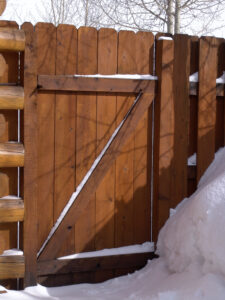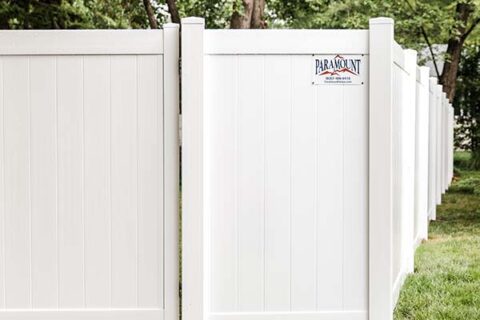Staining a Western Red Cedar Fence
Wood fencing is a popular choice for residential properties because of its strength, durability, appearance, and the privacy it provides. One of the wood choices in fencing is western red cedar. This wood variety needs very little in terms of treatments and, if left alone, will age into a beautiful silvery color. Many homeowners, however, prefer to stain their fences. Staining your fence can provide an additional layer of protection and can be done in a variety of stain colors. In this article, we’ll discuss how to prepare your fence before staining, how to choose the right stain, and we’ll walk you through how to apply the stain and maintain your fence.
Preparing the Fence for Staining

- Cleaning – Even if the fence is brand new, begin by cleaning the fence thoroughly to remove dirt, mildew, and any old stain. This might involve gentle pressure washing or using a cleaning solution designed for cedar wood.
- Drying – Allow the fence to dry completely after cleaning. The amount of drying time required can depend on weather conditions.
- Sanding – For the best staining results, sanding the wood lightly can be beneficial, especially if the fence isn’t new. This helps in opening up the wood pores to absorb the stain evenly.
Choosing the Right Stain
- Type of Stain – Selecting the appropriate stain type is very important. Options include transparent, semi-transparent, and solid stains. A semi-transparent stain is a good choice as it’s very durable and can be retouched without sanding or scraping.
- Quality – Don’t skimp on quality. While they may be more expensive, high-quality stains that are specifically designed for cedar wood can provide better protection and longer lasting results.
Staining Process
- Application Method – Stain can be applied using a brush, roller, or sprayer. Each method has its advantages and can affect the final appearance.
- Applying the Stain – Apply the stain evenly, working in small sections. Be sure to follow the manufacturer’s instructions for the best results.
- Number of Coats – The number of coats will depend on the type of stain and the desired appearance. Typically, one to two coats are sufficient.
- Drying Time – Allow adequate time for the stain to dry between coats and before using the fence. Drying time can vary based on weather conditions and the type of stain used.
Maintenance and Upkeep
- Regular Maintenance – Regular cleaning and occasional touch-ups can keep your western red cedar fence looking great for many years.
- Reapplication – Depending on the climate and the type of stain used, re-staining may be necessary every few years to maintain its protective qualities and appearance.
Tips for Best Results
- Weather Considerations – Stain your fence when the weather is dry and mild. Avoid staining in direct sunlight or when rain is expected.
- Test the Stain – Test the stain on a small, inconspicuous area of the fence to ensure the color and finish are what you desire.
- Safety Measures – Use appropriate safety gear when staining. This would include gloves, goggles, and a dust mask, especially if you’re using a sprayer to apply the stain. It’s also best to use canvas drop cloths to protect the ground and any nearby landscaping.
Staining your western red cedar fence is a smart investment in the longevity and aesthetic appeal of your property. The key to a successful staining project is meticulous preparation, selecting the right type and color of stain, then carefully following the instructions we’ve provided in this article. Once you’ve completed the project, it’s important to regularly maintain your fence. This would include inspecting it for any problems, retouching the stain where needed, and periodically re-staining to protect your fence and keep it looking great for many years.
Give Us a Call!
When you’re ready to select a new fence, or for any questions or concerns about fencing, check with the professionals at Paramount Fence . We have over 100 years of combined experience in providing our customers with the highest quality fencing products. We are a locally owned and operated fence company in the Fox Valley area servicing the Chicagoland Suburbs. We understand that each client is unique, and our fencing experts will work with you to ensure that you are provided with a fence that satisfies your needs for years to come.
We strive to provide excellent customer service, which is why we have been members of the American Fence Association for almost 20 years and members of the local Chicagoland Chapter of the Better Business Bureau (BBB) for almost 20 years. In fact, we have one of the highest customer service ratings with the Better Business Bureau in the area. For more information, visit our website or speak with us at 630-239-2714.


